Pewter Ltd: Impact of Accounting Standards on Financial Statements
VerifiedAdded on 2019/10/30
|8
|1670
|199
Report
AI Summary
This report, addressed to the Managing Director of Pewter Ltd., critically analyzes the impact of applying accounting standards on the company's financial statements. It highlights the importance of adhering to Australian Accounting Standards, particularly AASB 112 (Income Taxes) and AASB 118 (Revenue), to ensure a true and fair view of the company's financial position. The report discusses the correct accounting treatment for deferred tax assets and liabilities, emphasizing the use of accrual and matching concepts, and the consequences of non-compliance. It also evaluates the appropriate recognition of revenue from sales, cautioning against premature recognition and the need for separate accounting of retailer fees. The report concludes with a strong recommendation for compliance with accounting standards to avoid regulatory issues and to provide accurate and clear financial reporting.
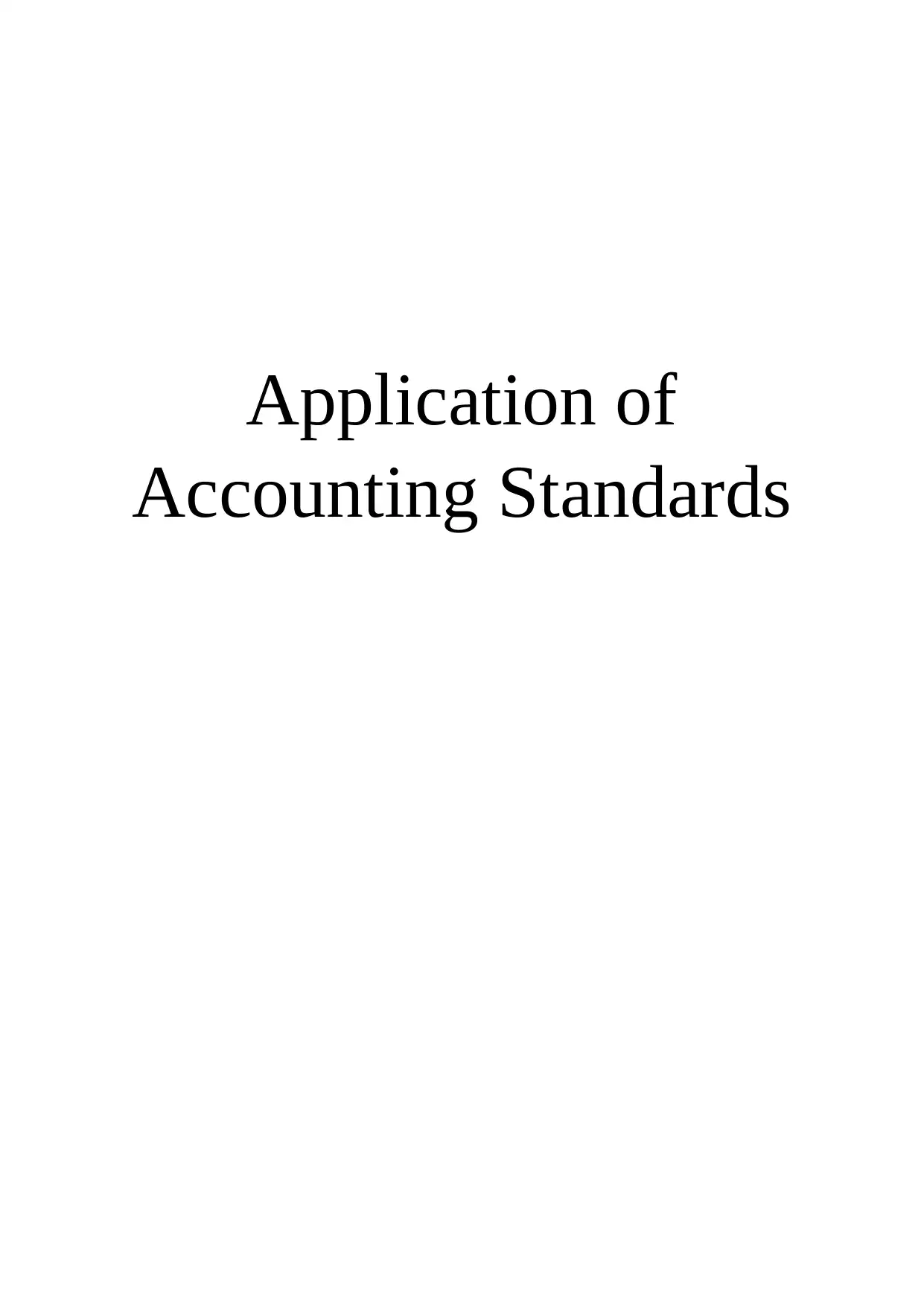
Application of
Accounting Standards
Accounting Standards
Paraphrase This Document
Need a fresh take? Get an instant paraphrase of this document with our AI Paraphraser
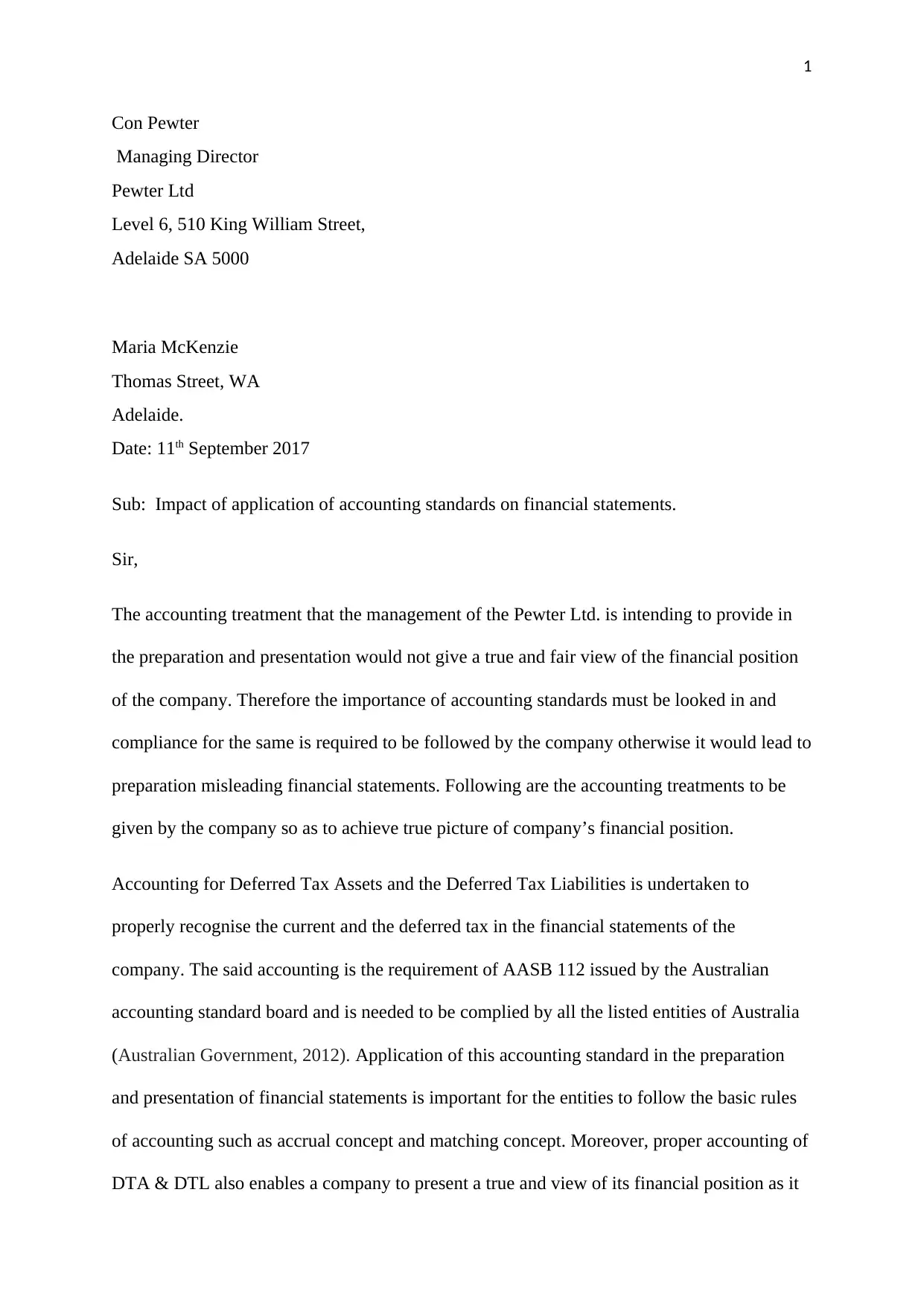
1
Con Pewter
Managing Director
Pewter Ltd
Level 6, 510 King William Street,
Adelaide SA 5000
Maria McKenzie
Thomas Street, WA
Adelaide.
Date: 11th September 2017
Sub: Impact of application of accounting standards on financial statements.
Sir,
The accounting treatment that the management of the Pewter Ltd. is intending to provide in
the preparation and presentation would not give a true and fair view of the financial position
of the company. Therefore the importance of accounting standards must be looked in and
compliance for the same is required to be followed by the company otherwise it would lead to
preparation misleading financial statements. Following are the accounting treatments to be
given by the company so as to achieve true picture of company’s financial position.
Accounting for Deferred Tax Assets and the Deferred Tax Liabilities is undertaken to
properly recognise the current and the deferred tax in the financial statements of the
company. The said accounting is the requirement of AASB 112 issued by the Australian
accounting standard board and is needed to be complied by all the listed entities of Australia
(Australian Government, 2012). Application of this accounting standard in the preparation
and presentation of financial statements is important for the entities to follow the basic rules
of accounting such as accrual concept and matching concept. Moreover, proper accounting of
DTA & DTL also enables a company to present a true and view of its financial position as it
Con Pewter
Managing Director
Pewter Ltd
Level 6, 510 King William Street,
Adelaide SA 5000
Maria McKenzie
Thomas Street, WA
Adelaide.
Date: 11th September 2017
Sub: Impact of application of accounting standards on financial statements.
Sir,
The accounting treatment that the management of the Pewter Ltd. is intending to provide in
the preparation and presentation would not give a true and fair view of the financial position
of the company. Therefore the importance of accounting standards must be looked in and
compliance for the same is required to be followed by the company otherwise it would lead to
preparation misleading financial statements. Following are the accounting treatments to be
given by the company so as to achieve true picture of company’s financial position.
Accounting for Deferred Tax Assets and the Deferred Tax Liabilities is undertaken to
properly recognise the current and the deferred tax in the financial statements of the
company. The said accounting is the requirement of AASB 112 issued by the Australian
accounting standard board and is needed to be complied by all the listed entities of Australia
(Australian Government, 2012). Application of this accounting standard in the preparation
and presentation of financial statements is important for the entities to follow the basic rules
of accounting such as accrual concept and matching concept. Moreover, proper accounting of
DTA & DTL also enables a company to present a true and view of its financial position as it
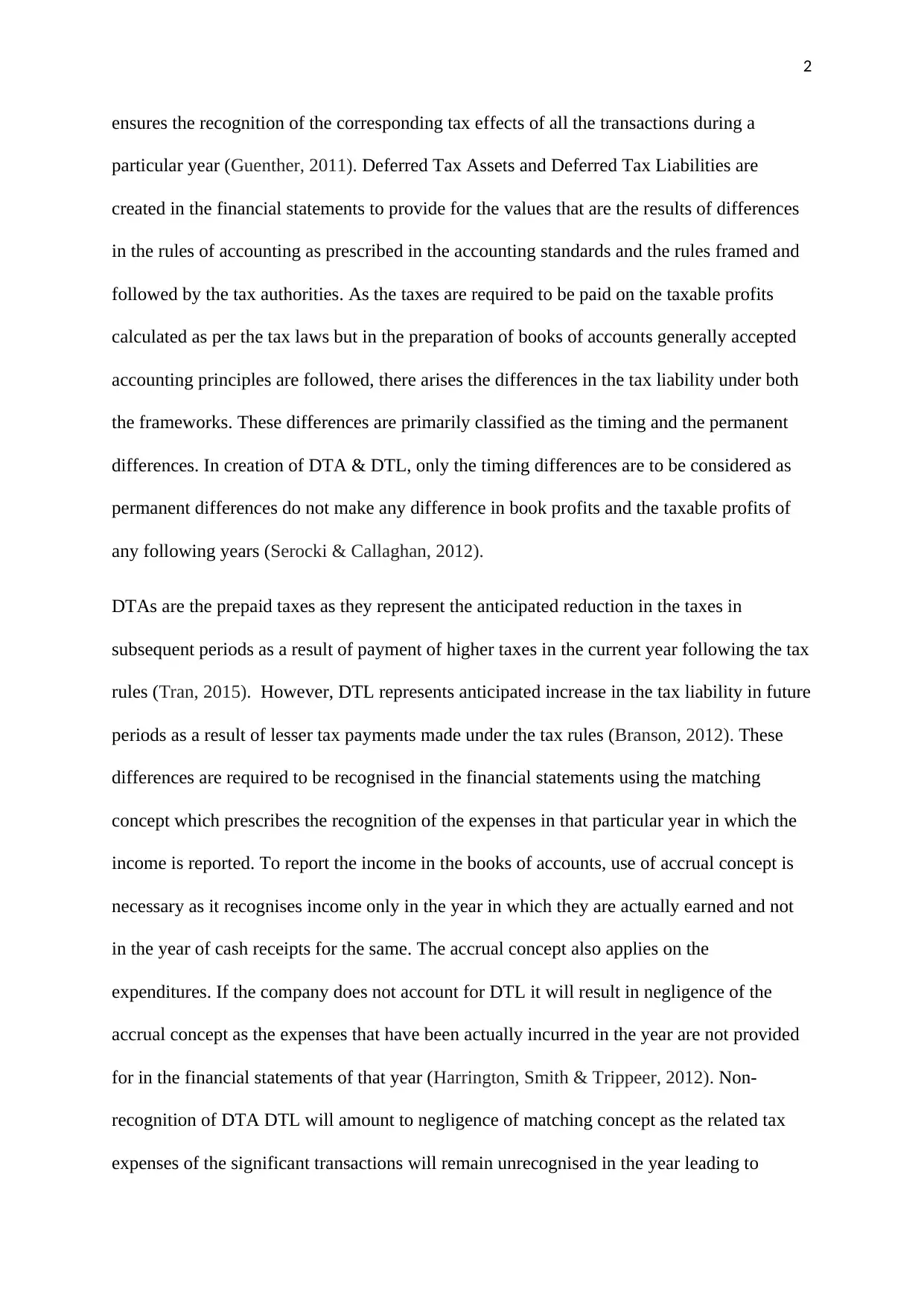
2
ensures the recognition of the corresponding tax effects of all the transactions during a
particular year (Guenther, 2011). Deferred Tax Assets and Deferred Tax Liabilities are
created in the financial statements to provide for the values that are the results of differences
in the rules of accounting as prescribed in the accounting standards and the rules framed and
followed by the tax authorities. As the taxes are required to be paid on the taxable profits
calculated as per the tax laws but in the preparation of books of accounts generally accepted
accounting principles are followed, there arises the differences in the tax liability under both
the frameworks. These differences are primarily classified as the timing and the permanent
differences. In creation of DTA & DTL, only the timing differences are to be considered as
permanent differences do not make any difference in book profits and the taxable profits of
any following years (Serocki & Callaghan, 2012).
DTAs are the prepaid taxes as they represent the anticipated reduction in the taxes in
subsequent periods as a result of payment of higher taxes in the current year following the tax
rules (Tran, 2015). However, DTL represents anticipated increase in the tax liability in future
periods as a result of lesser tax payments made under the tax rules (Branson, 2012). These
differences are required to be recognised in the financial statements using the matching
concept which prescribes the recognition of the expenses in that particular year in which the
income is reported. To report the income in the books of accounts, use of accrual concept is
necessary as it recognises income only in the year in which they are actually earned and not
in the year of cash receipts for the same. The accrual concept also applies on the
expenditures. If the company does not account for DTL it will result in negligence of the
accrual concept as the expenses that have been actually incurred in the year are not provided
for in the financial statements of that year (Harrington, Smith & Trippeer, 2012). Non-
recognition of DTA DTL will amount to negligence of matching concept as the related tax
expenses of the significant transactions will remain unrecognised in the year leading to
ensures the recognition of the corresponding tax effects of all the transactions during a
particular year (Guenther, 2011). Deferred Tax Assets and Deferred Tax Liabilities are
created in the financial statements to provide for the values that are the results of differences
in the rules of accounting as prescribed in the accounting standards and the rules framed and
followed by the tax authorities. As the taxes are required to be paid on the taxable profits
calculated as per the tax laws but in the preparation of books of accounts generally accepted
accounting principles are followed, there arises the differences in the tax liability under both
the frameworks. These differences are primarily classified as the timing and the permanent
differences. In creation of DTA & DTL, only the timing differences are to be considered as
permanent differences do not make any difference in book profits and the taxable profits of
any following years (Serocki & Callaghan, 2012).
DTAs are the prepaid taxes as they represent the anticipated reduction in the taxes in
subsequent periods as a result of payment of higher taxes in the current year following the tax
rules (Tran, 2015). However, DTL represents anticipated increase in the tax liability in future
periods as a result of lesser tax payments made under the tax rules (Branson, 2012). These
differences are required to be recognised in the financial statements using the matching
concept which prescribes the recognition of the expenses in that particular year in which the
income is reported. To report the income in the books of accounts, use of accrual concept is
necessary as it recognises income only in the year in which they are actually earned and not
in the year of cash receipts for the same. The accrual concept also applies on the
expenditures. If the company does not account for DTL it will result in negligence of the
accrual concept as the expenses that have been actually incurred in the year are not provided
for in the financial statements of that year (Harrington, Smith & Trippeer, 2012). Non-
recognition of DTA DTL will amount to negligence of matching concept as the related tax
expenses of the significant transactions will remain unrecognised in the year leading to
⊘ This is a preview!⊘
Do you want full access?
Subscribe today to unlock all pages.

Trusted by 1+ million students worldwide
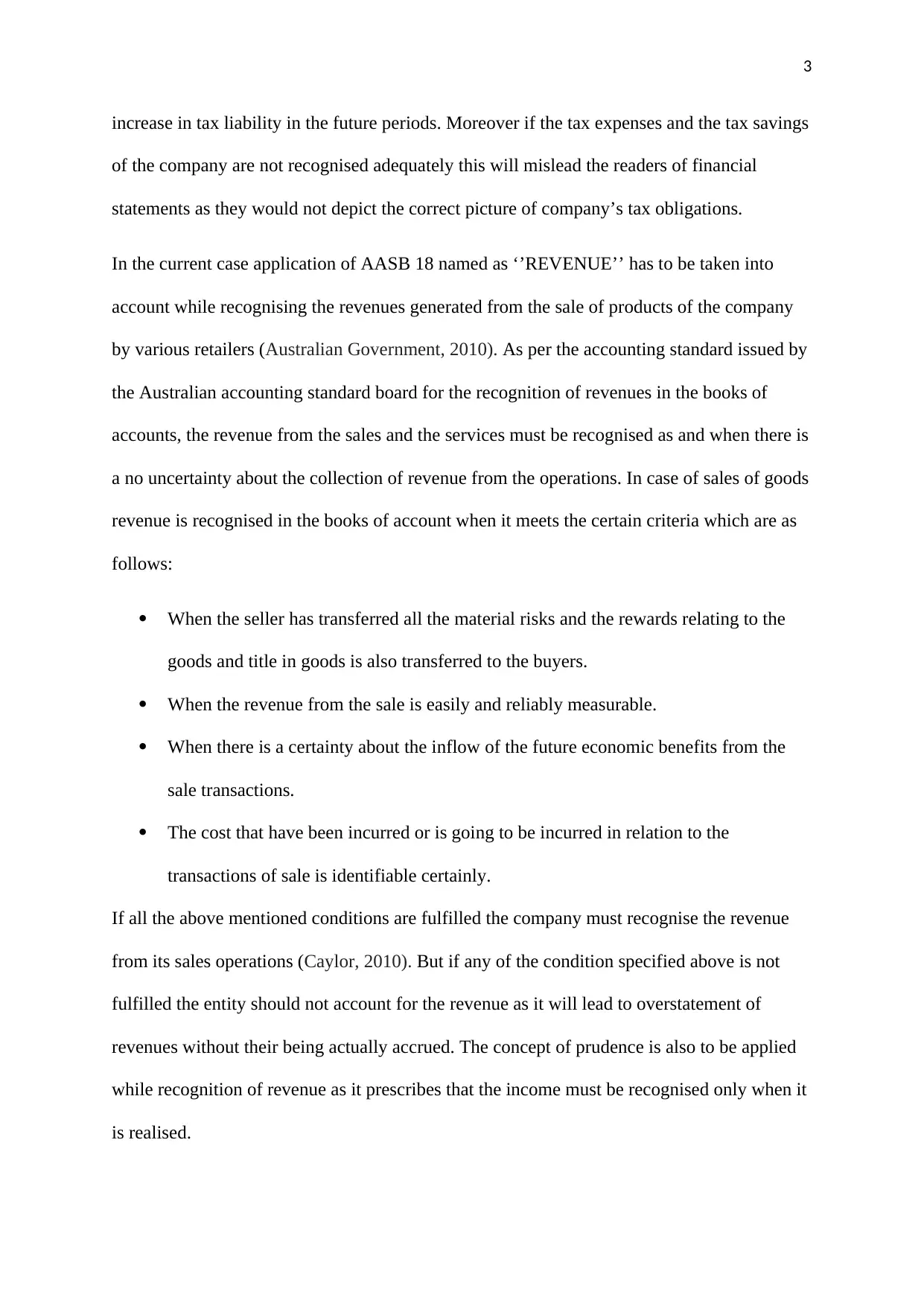
3
increase in tax liability in the future periods. Moreover if the tax expenses and the tax savings
of the company are not recognised adequately this will mislead the readers of financial
statements as they would not depict the correct picture of company’s tax obligations.
In the current case application of AASB 18 named as ‘’REVENUE’’ has to be taken into
account while recognising the revenues generated from the sale of products of the company
by various retailers (Australian Government, 2010). As per the accounting standard issued by
the Australian accounting standard board for the recognition of revenues in the books of
accounts, the revenue from the sales and the services must be recognised as and when there is
a no uncertainty about the collection of revenue from the operations. In case of sales of goods
revenue is recognised in the books of account when it meets the certain criteria which are as
follows:
When the seller has transferred all the material risks and the rewards relating to the
goods and title in goods is also transferred to the buyers.
When the revenue from the sale is easily and reliably measurable.
When there is a certainty about the inflow of the future economic benefits from the
sale transactions.
The cost that have been incurred or is going to be incurred in relation to the
transactions of sale is identifiable certainly.
If all the above mentioned conditions are fulfilled the company must recognise the revenue
from its sales operations (Caylor, 2010). But if any of the condition specified above is not
fulfilled the entity should not account for the revenue as it will lead to overstatement of
revenues without their being actually accrued. The concept of prudence is also to be applied
while recognition of revenue as it prescribes that the income must be recognised only when it
is realised.
increase in tax liability in the future periods. Moreover if the tax expenses and the tax savings
of the company are not recognised adequately this will mislead the readers of financial
statements as they would not depict the correct picture of company’s tax obligations.
In the current case application of AASB 18 named as ‘’REVENUE’’ has to be taken into
account while recognising the revenues generated from the sale of products of the company
by various retailers (Australian Government, 2010). As per the accounting standard issued by
the Australian accounting standard board for the recognition of revenues in the books of
accounts, the revenue from the sales and the services must be recognised as and when there is
a no uncertainty about the collection of revenue from the operations. In case of sales of goods
revenue is recognised in the books of account when it meets the certain criteria which are as
follows:
When the seller has transferred all the material risks and the rewards relating to the
goods and title in goods is also transferred to the buyers.
When the revenue from the sale is easily and reliably measurable.
When there is a certainty about the inflow of the future economic benefits from the
sale transactions.
The cost that have been incurred or is going to be incurred in relation to the
transactions of sale is identifiable certainly.
If all the above mentioned conditions are fulfilled the company must recognise the revenue
from its sales operations (Caylor, 2010). But if any of the condition specified above is not
fulfilled the entity should not account for the revenue as it will lead to overstatement of
revenues without their being actually accrued. The concept of prudence is also to be applied
while recognition of revenue as it prescribes that the income must be recognised only when it
is realised.
Paraphrase This Document
Need a fresh take? Get an instant paraphrase of this document with our AI Paraphraser
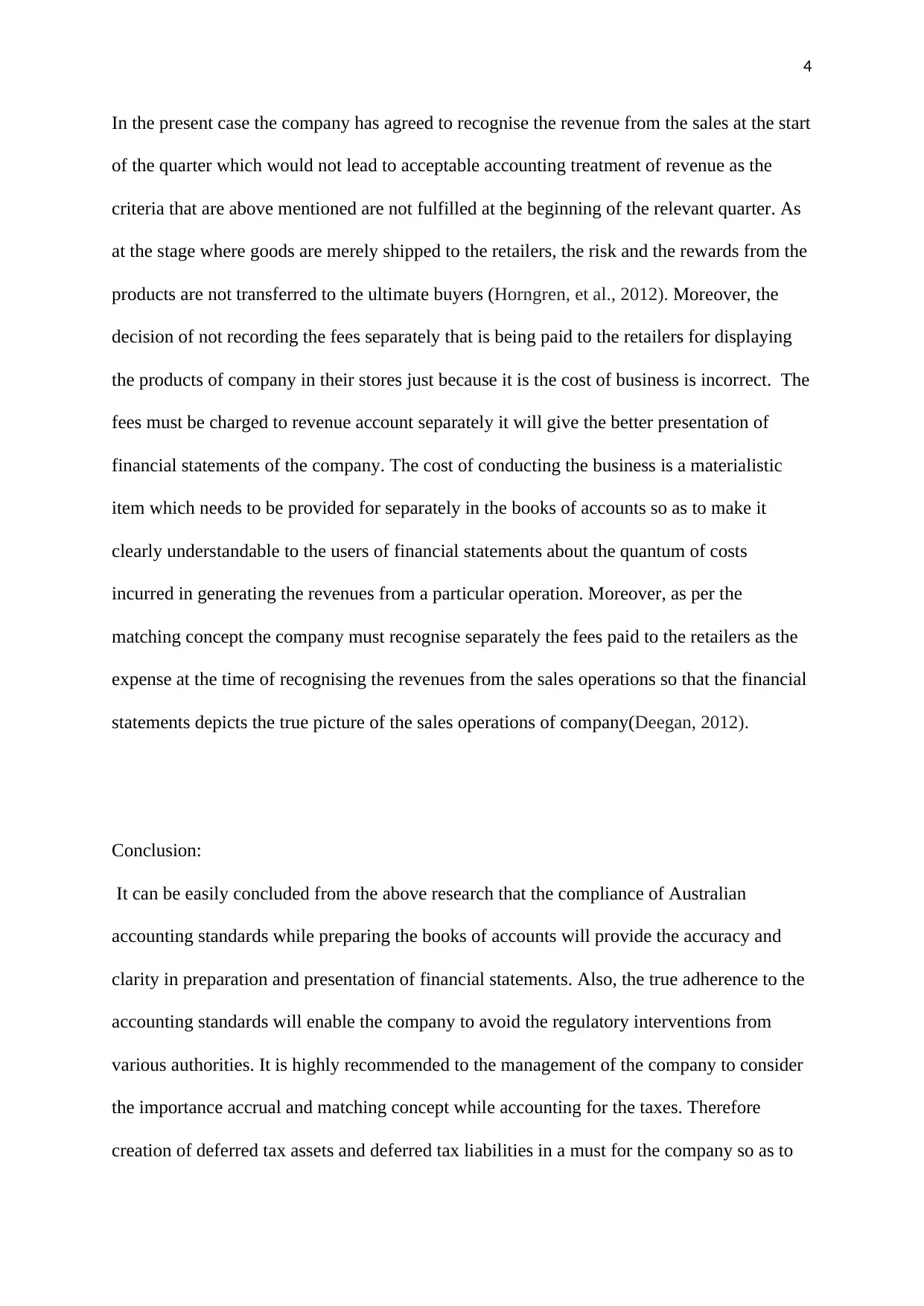
4
In the present case the company has agreed to recognise the revenue from the sales at the start
of the quarter which would not lead to acceptable accounting treatment of revenue as the
criteria that are above mentioned are not fulfilled at the beginning of the relevant quarter. As
at the stage where goods are merely shipped to the retailers, the risk and the rewards from the
products are not transferred to the ultimate buyers (Horngren, et al., 2012). Moreover, the
decision of not recording the fees separately that is being paid to the retailers for displaying
the products of company in their stores just because it is the cost of business is incorrect. The
fees must be charged to revenue account separately it will give the better presentation of
financial statements of the company. The cost of conducting the business is a materialistic
item which needs to be provided for separately in the books of accounts so as to make it
clearly understandable to the users of financial statements about the quantum of costs
incurred in generating the revenues from a particular operation. Moreover, as per the
matching concept the company must recognise separately the fees paid to the retailers as the
expense at the time of recognising the revenues from the sales operations so that the financial
statements depicts the true picture of the sales operations of company(Deegan, 2012).
Conclusion:
It can be easily concluded from the above research that the compliance of Australian
accounting standards while preparing the books of accounts will provide the accuracy and
clarity in preparation and presentation of financial statements. Also, the true adherence to the
accounting standards will enable the company to avoid the regulatory interventions from
various authorities. It is highly recommended to the management of the company to consider
the importance accrual and matching concept while accounting for the taxes. Therefore
creation of deferred tax assets and deferred tax liabilities in a must for the company so as to
In the present case the company has agreed to recognise the revenue from the sales at the start
of the quarter which would not lead to acceptable accounting treatment of revenue as the
criteria that are above mentioned are not fulfilled at the beginning of the relevant quarter. As
at the stage where goods are merely shipped to the retailers, the risk and the rewards from the
products are not transferred to the ultimate buyers (Horngren, et al., 2012). Moreover, the
decision of not recording the fees separately that is being paid to the retailers for displaying
the products of company in their stores just because it is the cost of business is incorrect. The
fees must be charged to revenue account separately it will give the better presentation of
financial statements of the company. The cost of conducting the business is a materialistic
item which needs to be provided for separately in the books of accounts so as to make it
clearly understandable to the users of financial statements about the quantum of costs
incurred in generating the revenues from a particular operation. Moreover, as per the
matching concept the company must recognise separately the fees paid to the retailers as the
expense at the time of recognising the revenues from the sales operations so that the financial
statements depicts the true picture of the sales operations of company(Deegan, 2012).
Conclusion:
It can be easily concluded from the above research that the compliance of Australian
accounting standards while preparing the books of accounts will provide the accuracy and
clarity in preparation and presentation of financial statements. Also, the true adherence to the
accounting standards will enable the company to avoid the regulatory interventions from
various authorities. It is highly recommended to the management of the company to consider
the importance accrual and matching concept while accounting for the taxes. Therefore
creation of deferred tax assets and deferred tax liabilities in a must for the company so as to
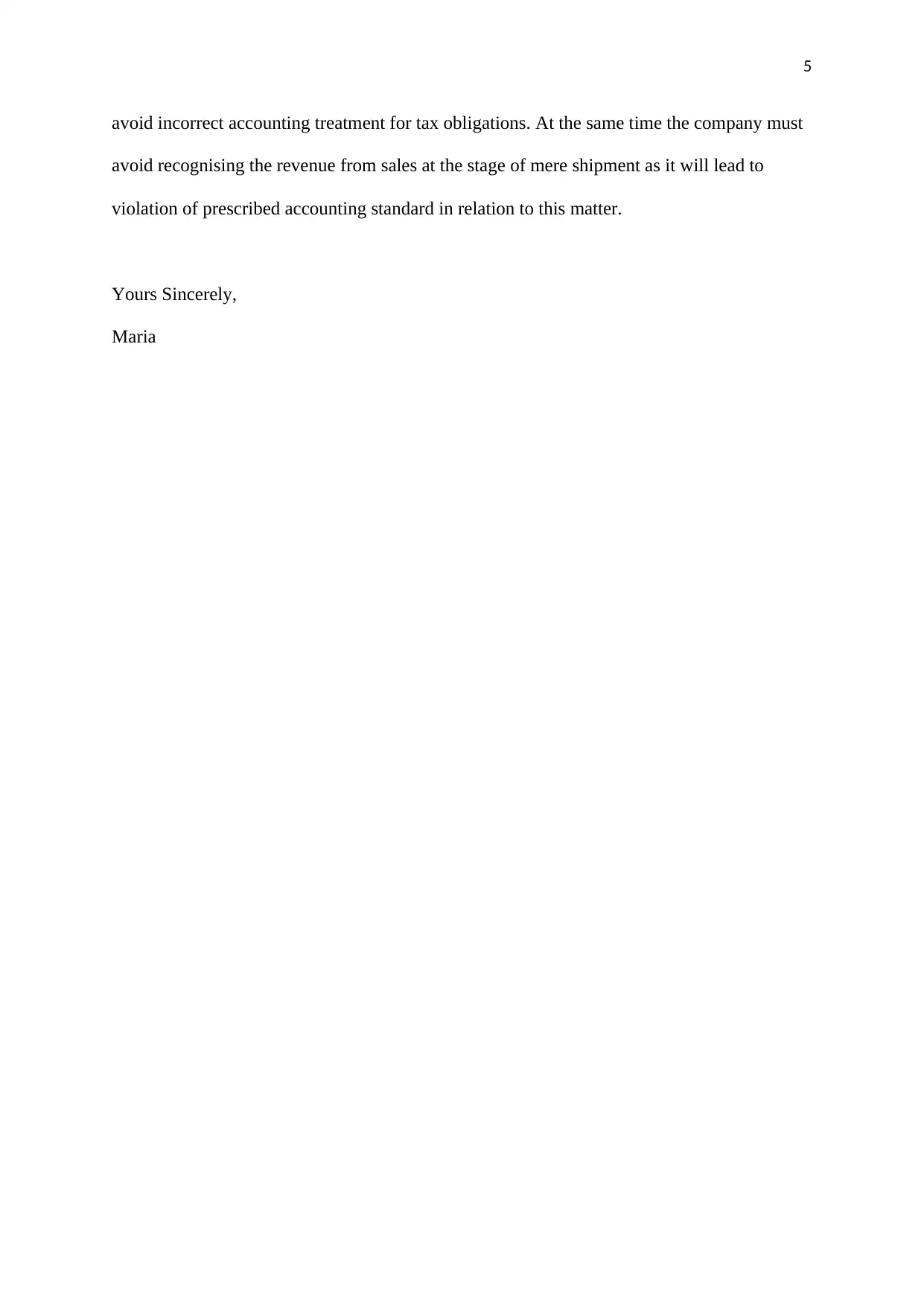
5
avoid incorrect accounting treatment for tax obligations. At the same time the company must
avoid recognising the revenue from sales at the stage of mere shipment as it will lead to
violation of prescribed accounting standard in relation to this matter.
Yours Sincerely,
Maria
avoid incorrect accounting treatment for tax obligations. At the same time the company must
avoid recognising the revenue from sales at the stage of mere shipment as it will lead to
violation of prescribed accounting standard in relation to this matter.
Yours Sincerely,
Maria
⊘ This is a preview!⊘
Do you want full access?
Subscribe today to unlock all pages.

Trusted by 1+ million students worldwide
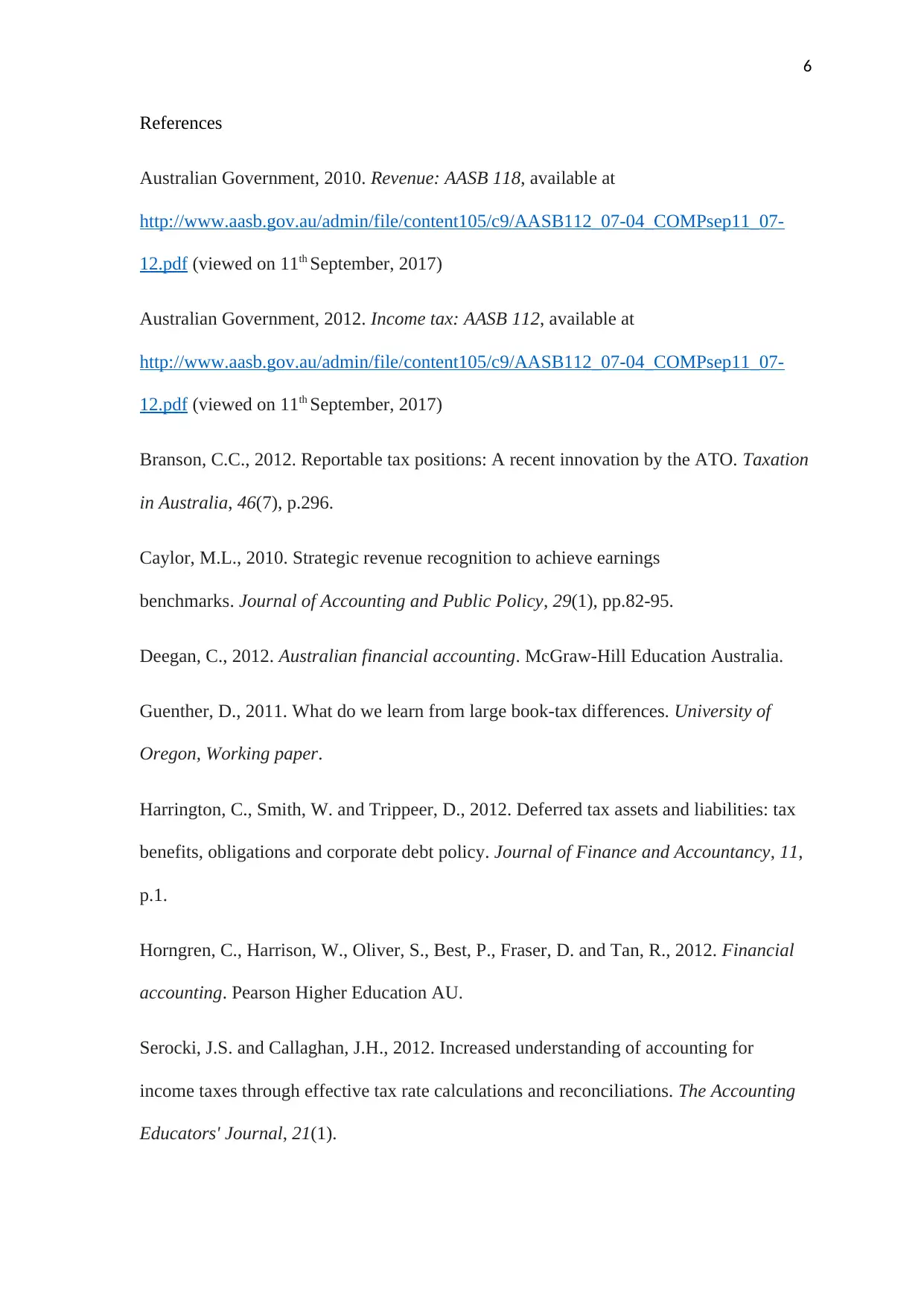
6
References
Australian Government, 2010. Revenue: AASB 118, available at
http://www.aasb.gov.au/admin/file/content105/c9/AASB112_07-04_COMPsep11_07-
12.pdf (viewed on 11th September, 2017)
Australian Government, 2012. Income tax: AASB 112, available at
http://www.aasb.gov.au/admin/file/content105/c9/AASB112_07-04_COMPsep11_07-
12.pdf (viewed on 11th September, 2017)
Branson, C.C., 2012. Reportable tax positions: A recent innovation by the ATO. Taxation
in Australia, 46(7), p.296.
Caylor, M.L., 2010. Strategic revenue recognition to achieve earnings
benchmarks. Journal of Accounting and Public Policy, 29(1), pp.82-95.
Deegan, C., 2012. Australian financial accounting. McGraw-Hill Education Australia.
Guenther, D., 2011. What do we learn from large book-tax differences. University of
Oregon, Working paper.
Harrington, C., Smith, W. and Trippeer, D., 2012. Deferred tax assets and liabilities: tax
benefits, obligations and corporate debt policy. Journal of Finance and Accountancy, 11,
p.1.
Horngren, C., Harrison, W., Oliver, S., Best, P., Fraser, D. and Tan, R., 2012. Financial
accounting. Pearson Higher Education AU.
Serocki, J.S. and Callaghan, J.H., 2012. Increased understanding of accounting for
income taxes through effective tax rate calculations and reconciliations. The Accounting
Educators' Journal, 21(1).
References
Australian Government, 2010. Revenue: AASB 118, available at
http://www.aasb.gov.au/admin/file/content105/c9/AASB112_07-04_COMPsep11_07-
12.pdf (viewed on 11th September, 2017)
Australian Government, 2012. Income tax: AASB 112, available at
http://www.aasb.gov.au/admin/file/content105/c9/AASB112_07-04_COMPsep11_07-
12.pdf (viewed on 11th September, 2017)
Branson, C.C., 2012. Reportable tax positions: A recent innovation by the ATO. Taxation
in Australia, 46(7), p.296.
Caylor, M.L., 2010. Strategic revenue recognition to achieve earnings
benchmarks. Journal of Accounting and Public Policy, 29(1), pp.82-95.
Deegan, C., 2012. Australian financial accounting. McGraw-Hill Education Australia.
Guenther, D., 2011. What do we learn from large book-tax differences. University of
Oregon, Working paper.
Harrington, C., Smith, W. and Trippeer, D., 2012. Deferred tax assets and liabilities: tax
benefits, obligations and corporate debt policy. Journal of Finance and Accountancy, 11,
p.1.
Horngren, C., Harrison, W., Oliver, S., Best, P., Fraser, D. and Tan, R., 2012. Financial
accounting. Pearson Higher Education AU.
Serocki, J.S. and Callaghan, J.H., 2012. Increased understanding of accounting for
income taxes through effective tax rate calculations and reconciliations. The Accounting
Educators' Journal, 21(1).
Paraphrase This Document
Need a fresh take? Get an instant paraphrase of this document with our AI Paraphraser
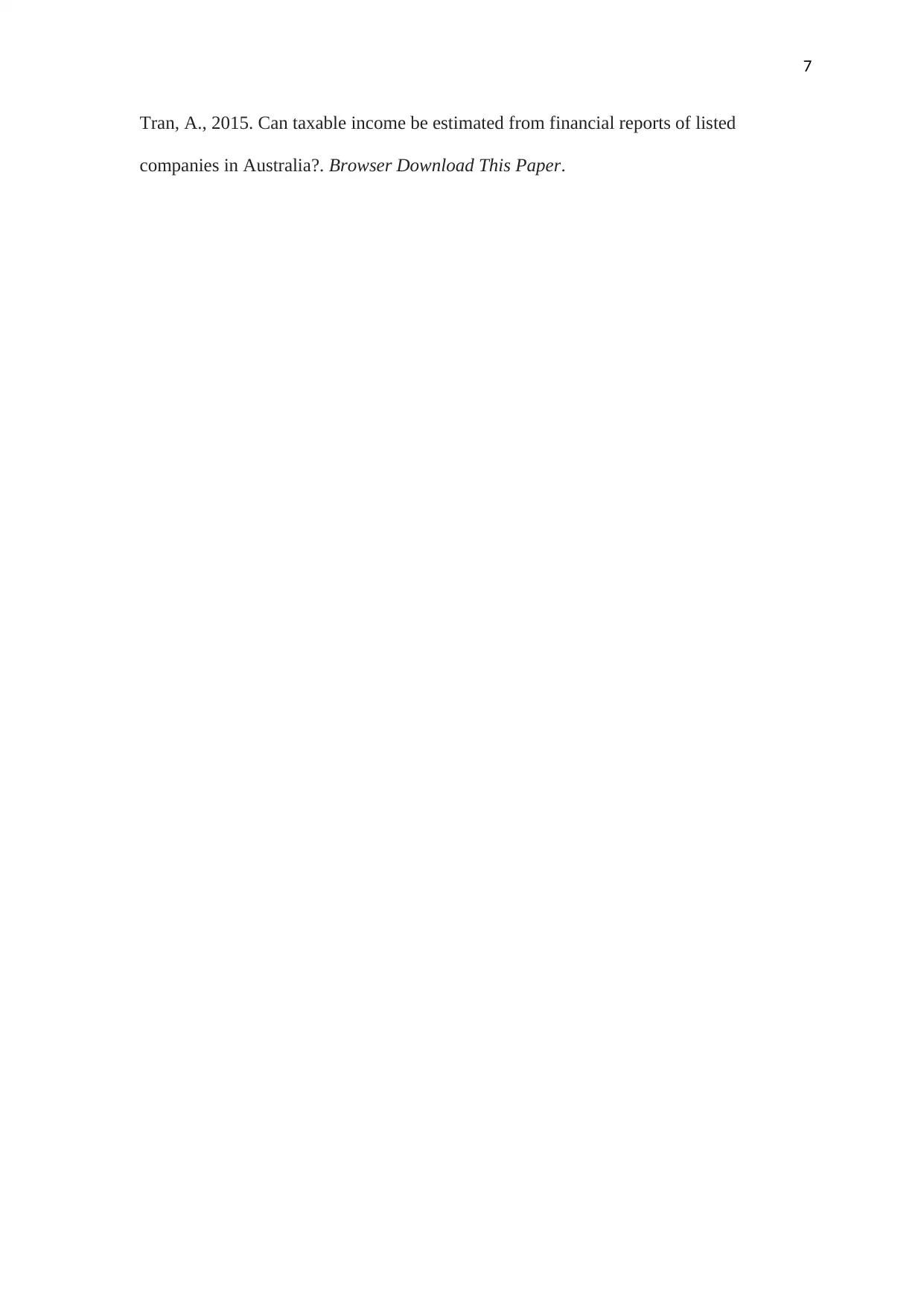
7
Tran, A., 2015. Can taxable income be estimated from financial reports of listed
companies in Australia?. Browser Download This Paper.
Tran, A., 2015. Can taxable income be estimated from financial reports of listed
companies in Australia?. Browser Download This Paper.
1 out of 8
Related Documents
Your All-in-One AI-Powered Toolkit for Academic Success.
+13062052269
info@desklib.com
Available 24*7 on WhatsApp / Email
![[object Object]](/_next/static/media/star-bottom.7253800d.svg)
Unlock your academic potential
Copyright © 2020–2025 A2Z Services. All Rights Reserved. Developed and managed by ZUCOL.





